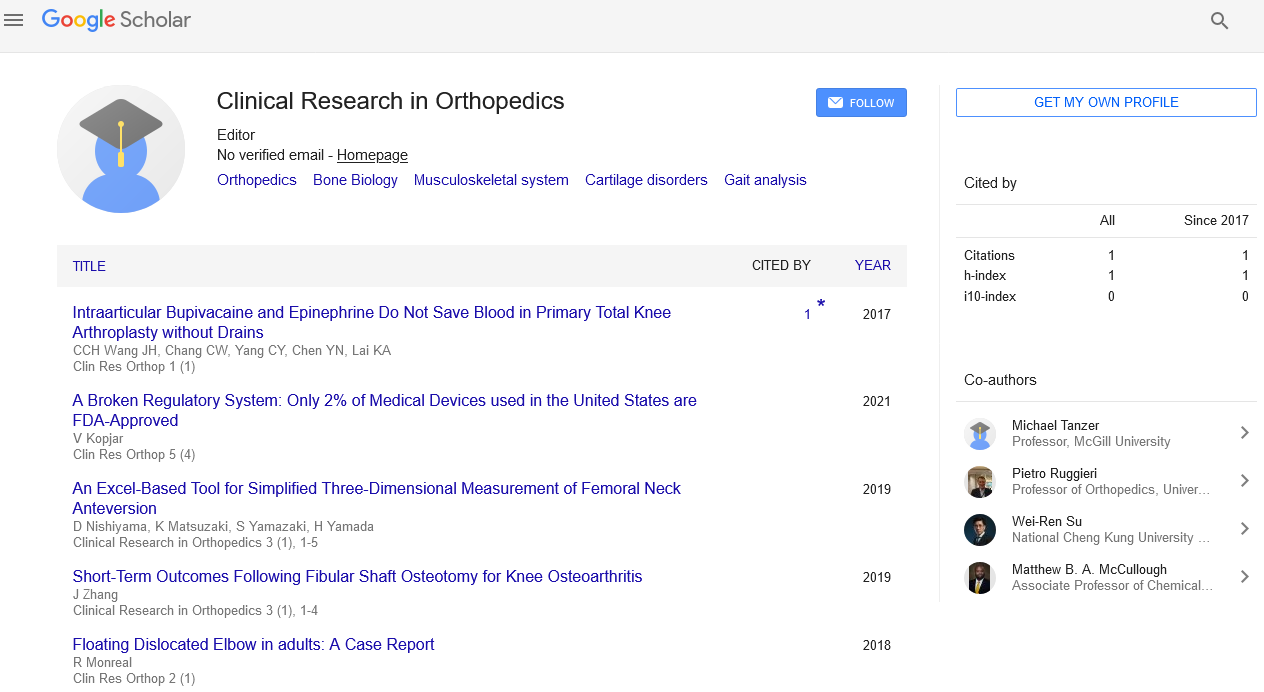Commentary, Clin Res Orthp Vol: 7 Issue: 2
Chondromalacia: Understanding Pathophysiology, Diagnosis, and Management of Runner's Knee
Mawatari Hirata*
1Department of Orthopedic Surgery, Saga University, Saga, Japan
*Corresponding Author: Mawatari Hirata,
Department of Orthopedic Surgery,
Saga University, Saga, Japan
E-mail: mawatari.hirata@cc.saga-u.ac.jp
Received date: 22 May, 2023, Manuscript No. CRO-23-107075;
Editor assigned date: 24 May, 2023, PreQC No. CRO-23-107075 (PQ);
Reviewed date: 08 June, 2023, QC No. CRO-23-107075;
Revised date: 16 June, 2023, Manuscript No. CRO-23-107075 (R);
Published date: 26 June, 2023 DOI: 10.35248/cro.1000078.
Citation: Hirata M (2023) Chondromalacia: Understanding Pathophysiology, Diagnosis and Management of Runner's Knee. Clin Res Orthp 7:2.
Description
Chondromalacia, also known as runner's knee, is a cartilage disorder characterized by the softening and degeneration of the cartilage on the underside of the patella. It commonly affects athletes, particularly runners, but can occur in individuals who engage in activities involving repetitive knee motions. It aims to provide a comprehensive understanding of chondromalacia, including its pathophysiology, clinical presentation, diagnosis, and management options.
Pathophysiology
Chondromalacia occurs due to various factors, including excessive or repetitive stress on the patellofemoral joint, improper alignment of the kneecap, muscle imbalances, and trauma. These factors lead to abnormal wear and tear of the cartilage, resulting in its degeneration and softening. Inflammatory processes may also contribute to the progression of the disorder.
Risk factors
Several risk factors contribute to the development of chondromalacia, including sports participation, particularly activities that involve running, jumping, or squatting. Other factors include muscle imbalances, joint instability, improper biomechanics, previous knee injuries, and certain anatomical factors. Understanding these risk factors can help identify individuals who are more susceptible to chondromalacia.
Clinical presentation
Chondromalacia typically presents with knee pain, especially during activities that involve bending the knee, such as climbing stairs, squatting, or prolonged sitting. Patients may also experience a grinding or popping sensation in the knee joint. Swelling and tenderness around the patella may be present, along with muscle weakness or tightness in the quadriceps and hamstrings.
Diagnosis
Diagnosing chondromalacia involves a combination of medical history, physical examination, and imaging studies. The physical examination may include tests to assess patellar alignment, joint stability, muscle strength, and range of motion. Imaging techniques such as Magnetic Resonance Imaging (MRI) or arthroscopy may be used to visualize the cartilage and assess the severity of the condition. It is important to note that the diagnosis of chondromalacia is typically made based on a combination of clinical findings and imaging results. The healthcare provider will evaluate all available information to determine the presence and severity of chondromalacia and develop an appropriate treatment plan tailored to the individual patient.
Management
Management of chondromalacia focuses on reducing pain, improving knee function, and preventing further cartilage damage. Conservative approaches include rest, activity modification, physical therapy, Non-Steroidal Anti-Inflammatory Drugs (NSAIDs), and the use of orthotic devices or braces. Strengthening exercises for the quadriceps and hamstrings, as well as stretching exercises, play a crucial role in rehabilitation. In cases where conservative measures fail, surgical interventions such as arthroscopy or realignment procedures may be considered.
Prevention and prognosis
Preventive measures for chondromalacia include proper warm-up and cool-down exercises, maintaining muscular strength and flexibility, using appropriate footwear, and avoiding excessive or repetitive stress on the knee joint. With appropriate management and adherence to rehabilitation protocols, the prognosis for chondromalacia is generally good, and most individuals can return to their normal activities with reduced symptoms.
Conclusion
Chondromalacia is a prevalent cartilage disorder that affects the knee joint, leading to pain and functional limitations. Understanding its pathophysiology, risk factors, clinical presentation, and diagnostic methods is essential for accurate diagnosis and effective management. The combination of conservative measures and surgical interventions, when necessary, can improve patient outcomes and restore knee function. Healthcare professionals should be knowledgeable about chondromalacia to provide appropriate care and support to individuals with this condition.
 Spanish
Spanish  Chinese
Chinese  Russian
Russian  German
German  French
French  Japanese
Japanese  Portuguese
Portuguese  Hindi
Hindi 